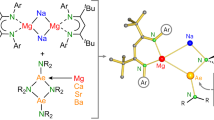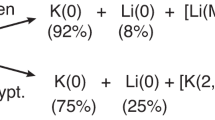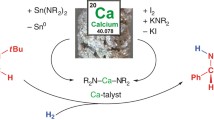Abstract
The cooperativity between MX2:XH alkaline-earth bonds and XH:NH3 hydrogen bonds (M = Mg, Ca; X = F, Cl) was investigated at the G4 level of theory. The cooperativity between these two non-covalent linkages is extremely large, to the point that the increase in their bond dissociation enthalpies may be as large as 240%. More importantly, the weaker the interaction, the larger the increase, so in some cases the linkage that stabilizes the most is the alkaline-earth bond, whereas in others is the hydrogen bond. In all cases, the formation of the MX2:XH:NH3 ternary complex is followed by a spontaneous proton transfer, very much as previously found for the Be-containing analogues. Similarly, MX2:FCl:NH3 complexes evolve from a chlorine-shared ternary complex (MX2F···Cl···NH3) or from an ion pair (MX2F−···NH3Cl+) if M = Ca. Although F is the only halogen without σ-hole, MgCl2 derivatives induce the appearance of a σ-hole on it, though less deep than those induced by BeCl2. We have also studied whether Mg and Ca bond-containing complexes MR2:FY (R = H, F, Cl; Y = NH2, OH, F, Cl) may react to form radicals, as it has been found for the Be-containing analogues. These interactions provoke a drastic decrease in the F–Y bond dissociation enthalpy, very much as the one reported for the corresponding Be-analogues, to the point that in some cases the formation of the corresponding MR2F• + Y· radicals becomes exothermic. Hence, the general conclusion of this study is that Mg or Ca derivatives give place to similar or even larger perturbations on the electron density than those induced by Be, a result not easily predictable.






Similar content being viewed by others
References
Mahadevi AS, Sastry GN (2016) Chem Rev 116:2775–2825
Biedermann F, Schneider HJ (2016) Chem Rev 116:5216–5300
Mó O, Yáñez M, Elguero J (1992) J Chem Phys 97:6628–6638
Hurtado M, Yáñez M, Herrero R, Guerrero A, Dávalos JZ, Abboud J-LM, Khater B, Guillemin JC (2009) Chem Eur J 15:4622–4629
Martín-Sómer A, Lamsabhi A, Yáñez M, Davalos JZ, Gonzalez J, Ramos R, Guillemin JC (2012) Chem Eur J 18:15699–15705
Yáñez M, Mó O, Alkorta I, Elguero J (2013) Chem Eur J 35:11637–11643
Albrecht L, Boyd RJ, Mó O, Yáñez M (2012) Phys Chem Chem Phys 14:14540–14547
Mó O, Yáñez M, Alkorta I, Elguero J (2012) J Chem Theory Comput 8:2293–2300
Albrecht L, Boyd RJ, Mó O, Yáñez M (2014) J Phys Chem A 118:4205–4213
Yáñez M, Mó O, Alkorta I, Elguero J (2013) Chem Phys Lett 590:22–26
Mó O, Yáñez M, Alkorta I, Elguero J (2014) Mol Phys 112:592–600
Brea O, Mó O, Yáñez M, Alkorta I, Elguero J (2015) Chem Eur J 21:12676–12682
Brea O, Alkorta I, Mó O, Yáñez M, Elguero J, Corral I (2016) Angew Chem Eng Int Ed 55:8736–8739
Bauzá A, Frontera A (2017) Chem Eur J 23:5375–5380
Curtiss LA, Redfern PC, Raghavachari K (2007) J Chem Phys 126:84108
Møller C, Plesset M (1936) Phys Rev 46
Krishnan R, Pople JA (1978) Int J Quantum Chem 14:91–100
Raghavachari K, Trucks GW, Pople JA, Head-Gordon M (1989) Chem Phys Lett 157:479–483
Bader RFW (1990) Atoms in molecules. A quantum theory. Clarendon Press, Oxford
Savin A, Nesper R, Wengert S, Fäsler TF (1997) Angew Chem Int Ed Engl 36:1808–1832
Weinhold F (1998) In: von Schleyer PR, Allinger NL, Clark T, Gasteiger J, Kollman PA, Schaefer HF III, Schreiner PR (eds) Encyclopedia of computational chemistry, vol 3. Wiley, Chichester, pp 1792–1811
Reed AE, Curtiss LA, Weinhold F (1988) Chem Rev 88:899–926
Wiberg KB, Bader RFW, Lau CDH (1987) J Am Chem Soc 109:985–1001
Tood AK (2017) Journal. AIMAll (Version 17.11.14)
Noury S, Krokidis X, Fuster F, Silvi B (1999) Comput Chem 23:597–604
Glendening ED, Badenhoop JK, Reed AE, Carpenter JE, Bohmann JA, Morales CM, Landis CR, Weinhold F (2013) NBO 6.0. University of Wisconsin, Madison
Alkorta I, Elguero J, Mó O, Yáñez M, Del Bene JE (2015) Phys Chem Chem Phys 17:2259–2267
Acknowledgements
This work was supported by the financial support received from the Ministerio de Economía, Industria y Competitividad (Projects CTQ2015-63997-C2 and CTQ2016-76061-P), and Comunidad Autónoma de Madrid (S2013/MIT2841, Fotocarbon). The CTI (CSIC) and the Centro de Computación Científica of the UAM (CCC-UAM) are also acknowledged for their continued computational support.
Author information
Authors and Affiliations
Corresponding author
Additional information
Publisher's Note
Springer Nature remains neutral with regard to jurisdictional claims in published maps and institutional affiliations.
Published as part of the special collection of articles derived from the 11th Congress on Electronic Structure: Principles and Applications (ESPA-2018).
Electronic supplementary material
Below is the link to the electronic supplementary material.
Rights and permissions
About this article
Cite this article
Montero-Campillo, M.M., Brea, O., Mó, O. et al. Gas-phase reactivity tuned through the interaction with alkaline-earth derivatives. Theor Chem Acc 138, 62 (2019). https://doi.org/10.1007/s00214-019-2424-3
Received:
Accepted:
Published:
DOI: https://doi.org/10.1007/s00214-019-2424-3




